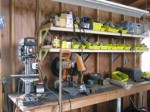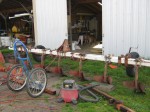My Workshop
 Among the very best improvements we have ever made on our farm is building an enclosed workshop four years ago. By most standards it is quite modest—30×30 feet, with unfinished walls and a bare concrete floor. But it does have workbenches, lots of shelf space, good lighting and enough floor space to work on two trucks or tractors at once if need be. And most importantly, it has a place for everything—(although everything isn’t always in its’ place).
Among the very best improvements we have ever made on our farm is building an enclosed workshop four years ago. By most standards it is quite modest—30×30 feet, with unfinished walls and a bare concrete floor. But it does have workbenches, lots of shelf space, good lighting and enough floor space to work on two trucks or tractors at once if need be. And most importantly, it has a place for everything—(although everything isn’t always in its’ place).
In a system of shelves, bins, buckets and boxes that probably only makes sense to me, I can keep all of our tools, spare parts, fasteners, lubricants and general supplies somewhat organized.
 One of the things I have learned over the years is that the easier you make something to do, the more likely you are to do it. This is especially true when it comes to maintenance. In the old days we would find a relatively flat place, throw down a tarp, haul the necessary tools out of the garage and do maintenance and repairs outside in the yard. Not only did the extra steps involved mean that we were more likely to defer maintenance on some things, it also meant more lost or misplaced tools and when it rained we were out of luck.
One of the things I have learned over the years is that the easier you make something to do, the more likely you are to do it. This is especially true when it comes to maintenance. In the old days we would find a relatively flat place, throw down a tarp, haul the necessary tools out of the garage and do maintenance and repairs outside in the yard. Not only did the extra steps involved mean that we were more likely to defer maintenance on some things, it also meant more lost or misplaced tools and when it rained we were out of luck.Another major advantage to having a workshop is that it also serves to house my modest metal fabrication set-up. We lding is an essential skill for farmers not only for making repairs, but also for making or adapting equipment for use in the field or packing shed. Because we farm on such a small scale relative to the farms that surround us, it is hard to find used equipment that is suitable for our scale. One option is to buy large scale equipment and alter it to fit our needs. One example of this is the lister-bar I bought last week with my cousin Josh who was also in need of one (these are tractor drawn implements that we use to make our “raised” beds with). We plan to cut it in half to make two listers out of one 20 footer, and as an added bonus, with a little cutting and welding we can also make two sets of line-markers out of the single set we bought it with.
lding is an essential skill for farmers not only for making repairs, but also for making or adapting equipment for use in the field or packing shed. Because we farm on such a small scale relative to the farms that surround us, it is hard to find used equipment that is suitable for our scale. One option is to buy large scale equipment and alter it to fit our needs. One example of this is the lister-bar I bought last week with my cousin Josh who was also in need of one (these are tractor drawn implements that we use to make our “raised” beds with). We plan to cut it in half to make two listers out of one 20 footer, and as an added bonus, with a little cutting and welding we can also make two sets of line-markers out of the single set we bought it with.
We always end up with a long list of repairs and improvements that we have little time for during the season. And during winter, when the rains keep us out of the fields, it is invaluable to have a clean, well-lit, dry place to catch up on things. Coming into the first week of the CSA, we are almost at the bottom of the list—but not quite.
(When Steve told me he was going to buy some used equipment with his cousin Josh and they were going to share it by cutting it in half I thought it was a lame joke. Then he came home with this monster. This ridiculously long lister bar will be cut in half so both Steve and Josh can use it on their small scale farms. – Jeanne)
Search High Ground Site
High Ground Favorites Cloud
apples arugula basil beets braise broccoli carrots cauliflower celery chard cheese cilantro dressing fennel fish herbs kale leeks lemon lettuce Meyer lemon mint mushrooms nuts onions oregano parsley peppers pork potatoes quickles radishes salad sauce saute scallions soup strawberries summer squash tomatoes topping vegan vegetarian vinaigrette winter squash



